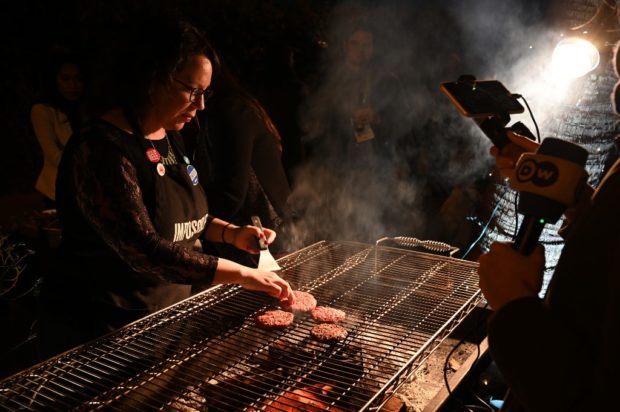Meaty mushrooms, printed “steaks” and NASA discoveries — the latest array of meat alternatives has been showcased at the Good Food Conference in San Francisco, United States recently.
At various stages of production, here are a few of the ideas gaining attention as producers and investors focus on the booming vegetarian sector.

The Impossible Burger 2.0, a plant-based vegan burger that tastes like real beef was introduced at a press event in Las Vegas, Nevada on Jan. 7, 2019. Image: AFP/Robyn Beck
‘Magic’ mushrooms
The Ecovative company was founded in New York in 2007 to develop biodegradable packaging made from mycelium, the root structure of mushrooms.
That project was to find alternatives to plastic packaging — but the company then applied the same technique to make a leather substitute, and is now moving onto a meat alternative.
“You can grow a mushroom into a unique form” by changing its growing environment, said co-founder Gavin McIntyre.
Once mature, the mushroom “has the structure and texture to simulate whole cut meat” — not just burgers and sausages — and can be a “blank canvas” for other ingredients to add taste and nutrients.
The company is seeking partners to develop its product.
3D printer
Italian technology entrepreneur Giuseppe Scionti was a university specialist in tissue engineering, who worked on creating human tissue using a 3D printer.
He has applied his expertise to the food sector after founding the Spanish start-up NovaMeat that uses plant ingredients such as rice, pea protein and seaweed.
The printer uses the material to create alternative beef steaks and chicken breasts, with texture claimed to match real meat.
NovaMeat announced at the conference that it had raised $2 million from New Crop Capital, a specialty food fund, for further development of meat substitute technology.
Volcanic organisms
Sustainable Bioproducts, based in Chicago and led by Frenchman Thomas Jonas, is developing a new way to grow edible protein using NASA research.
The company’s technology emerged out of studying organisms that survive extreme temperatures in Yellowstone National Park’s volcanic springs.
It said it has discovered a so-called “complete protein” with all nine amino acids essential to the functioning of the human body, and that it can re-create the protein to manufacture food.
The company, which plans to open a factory next year, recently raised $33 million in financing from venture capital funds and food and agribusiness companies. RGA/JB
RELATED STORIES:
How fast is society’s meat consumption evolving?
Meatsplainer: How new plant-based burgers compare to beef

